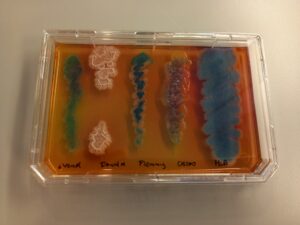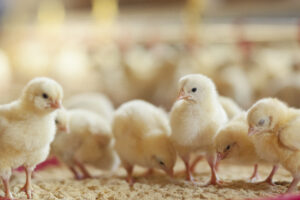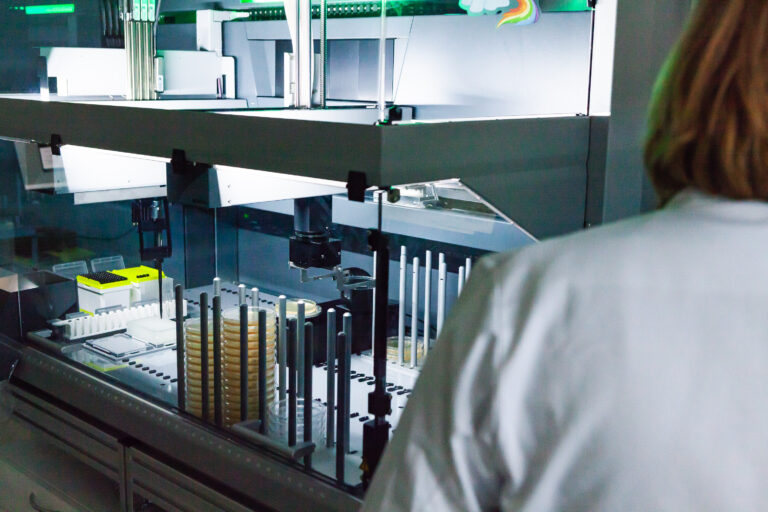Probiotics are improving the efficiency of poultry production. Chloe Ryan discovers more in a laboratory in Denmark
In a laboratory just outside Copenhagen, Danish scientist Dorthe Sandvang, is enthusing about bacterial cultures. “Look at this! It is art!” she almost shouts as she waves her arms around holding petri dishes with colourful swirls, blobs and streaks.
She is speaking to UK poultry vets, agricultural managers and nutritionists about how she developed a probiotic made of three strains of bacteria, which can be used to improve the gut health of poultry. Trials have shown the product – available commercially from Elanco as GalliPro Fit – is effective in helping birds manage infections such as enterococcus cecorum.

The group in the lab travelled from the UK to Copenhagen in March to learn more about the development of GalliPro Fit, along with poultry professionals from other European nations including Italy, Türkiye, and Spain, all of whom are customers of Elanco.
Sandvang – a vet and microbiologist – is department manager, poultry animal and plant health and nutrition, for Novonesis. Novonesis was formed earlier this year in a merger between Christian Hansen and Novozymes, and the company employs 10,000 globally with a turnover of approximately €3.7 billion.
In the UK, Elanco is the distributor for Gallipro Fit, and since 2023 it has been used by one major integrator to successfully tackle an enterococcus challenge on farms. Now the two firms are aiming to broaden the product’s distribution in the UK and across Europe, and are embarking on a new series of clinical trials to try and prove what has been demonstrated anecdotally – that the probiotic has a whole range of potential benefits in boosting the performance of commercial poultry, in broilers, as well as providing benefits associated with better gut health including improved FCR and EPEF.
The assembled group listen to Sandvang describe how she and her team isolated the strains from samples of animal faeces that she gathered from various sites in the Danish countryside, then in a process of trial and error combined three bacteria she named the King, the Queen and the Knight, developed the final formula that is now cultured in Novonesis’ factory in Germany and shipped around the world.
She details the main challenges faced by commercial poultry – heat stress, day seven mortality, salmonella, and inflammation. All of these can be aided with better gut health, and gut health can be improved with probiotics. In a lengthy process, the strains and concentrations are selected to ensure the best combination for the cheapest price.
“Some bacteria are good at enzyme production, some are good at inhibiting pathogens, some are good at adhesion to intestinal walls. Different bacteria have different powers,” she says. The strains were selected due to their ability to rapidly colonise the intestine to compete against (and therefore inhibit) undesirable bacteria, as well as beneficial enzyme production which increases nutrient availability from feed.

“Why do we do this?” she says, arms splayed. “We want to enhance the poultry industry through intestinal health. Chicken is the most consumed meat on the planet so if we can improve efficiency we can make a real difference.”
MICROBIOME
The group was also given a briefing on the microbiome, a word that describes the eco-system within an animal’s gut, and why a robust microbiome with a broad diversity of bacteria is important for good health.
Gisle Vestergaard, microbiome lead, animal & plant health and nutrition, at Novonesis, described how scientific understanding of the microbiome is improving all the time and with it the potential consequences of a poor microbiome, including in humans irritable bowel syndrome (IBS), childhood asthma, allergies and eczema, and in later life, Alzheimer’s disease, Parkinson’s, and depression. “Imbalance in the gut is involved in many diseases,” said Vestergaard.
The same is true for poultry. A gut with a large diversity of bacteria keeps the animal healthy and helps keep pathogens away. Scientists determine microbiome robustness with a DNA microbial sample. The DNA is sequenced, and bacteria are categorised by sequence similarity. The scientist will look at every single bacterial species in the gut. Animals with a disrupted balance of bacteria in their gut are prone to compromised cell to cell junctions, making them vulnerable to inflammatory microorganisms.
The microbiome can be challenged by many factors including antibiotics, which cause acute stress, chronic stress such as heat stress, pathogenic bacteria such as salmonella, e coli, and nutritional factors such as mycotoxins. Certain factors determine whether an animal is likely to have a robust gut microbiome, including animal genetics, diet, age, early life exposure, and the housing environment.
INTESTINAL INTEGRITY
George Gould, principle technical advisor of global poultry at Elanco, talked to the group about intestinal integrity (I2), which he defined as the optimal functionality of the intestinal tract.
This was important, he said, because 65- 70% of the cost of broiler production is feed, and 70-80% of the carbon cost of broiler production is feed. Threats to intestinal integrity include coccidiosis, clostridium perfringens, bacterial enteritis, and viral challenges.

“The earlier in life a healthy gut microbiome is developed, the better, as this gives maximum time for benefits to be maximised,” he said.
THE ROLE OF PROBIOTICS
Laura Hoving, Novonesis’ technical service manager for poultry, discussed how probiotics could play a role in promoting a healthy gut.
By populating the digestive tract and changing the environment to benefit themselves, probiotics can alter the gut microbiome composition, promoting intestinal integrity and positively affecting performance under commercial conditions.
There is a relationship between gut and brain, Hoving said. It means stressful situations are perceived as less stressful in animals with a strong gut. “This means there is a big welfare benefit as well.” She cited trials in south America showing how probiotics impact bird welfare and stress reactions.
“On farm, a robust microbiome leads to better performance, lower disease outbreaks and therefore lower antibiotic use. Also, there are lower levels of carcase condemnation. All of that is money,” she added.
MODES OF ACTION
Gallipro Fit has four modes of action, which are well tested and peer reviewed. These are to increase digestion, form biofilm, directly interact with harmful bacteria, and to support gut barrier functions.
The group also spoke with Erwan Philippe, vice president of global sales at Novonesis, who described the company’s core business, which is developing enzymes and functional proteins that are used in food and drink. More than half the cheese in the world is made with strains developed by Novonesis, for example.
But in addition to this, the company also supplies enzymes used in household detergents, enzymes used in biofuels, and – the reason the group made the visit – biological agents used in agriculture to improve animal and plant health.
“Our products help make crops more robust, and in animal health, our products help improve feed conversion, support the health of a flock, and optimise productivity,” said Philippe.
This was important, he added, because food production is responsible for over a quarter of all greenhouse gas emissions, so making any part of the process more efficient can have huge benefits – for the animals, for the industry, and for the planet.
WHAT IS GALLIPRO FIT?
GalliPro Fit is a triple-strain poultry probiotic that supports gut health. It can be incorporated into feed rations and helps birds build a robust gut microbiome, allowing them to optimise feed efficiency and therefore performance.
The product contains three naturally occurring bacterial strains: 2 B. subtilis and one of B. amyloliquefacie.
It can be used in two different ways. Firstly, to tackle a bacterial challenge, such as Enterococcus or E. Coli, and secondly to maintain long term performance


